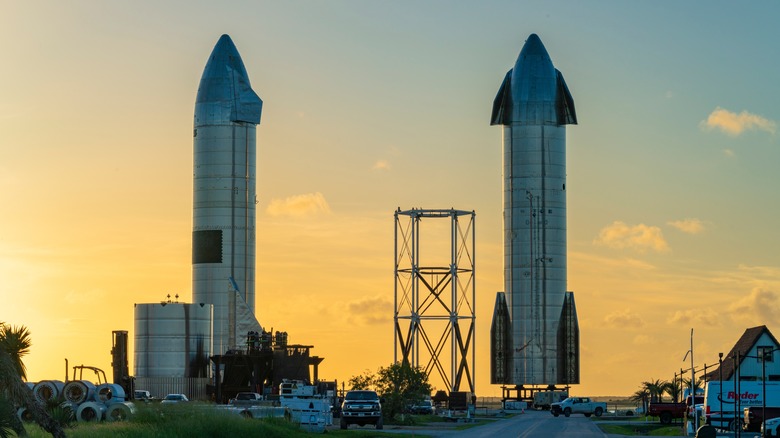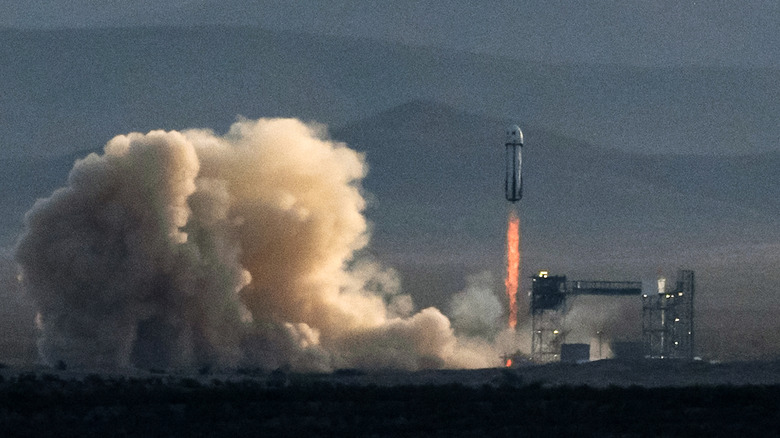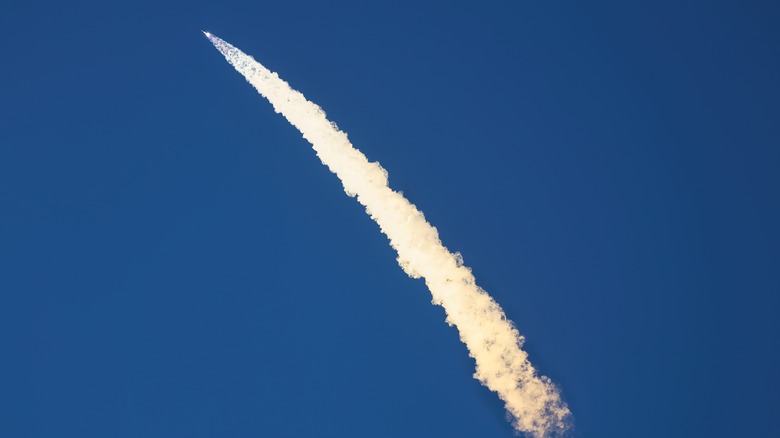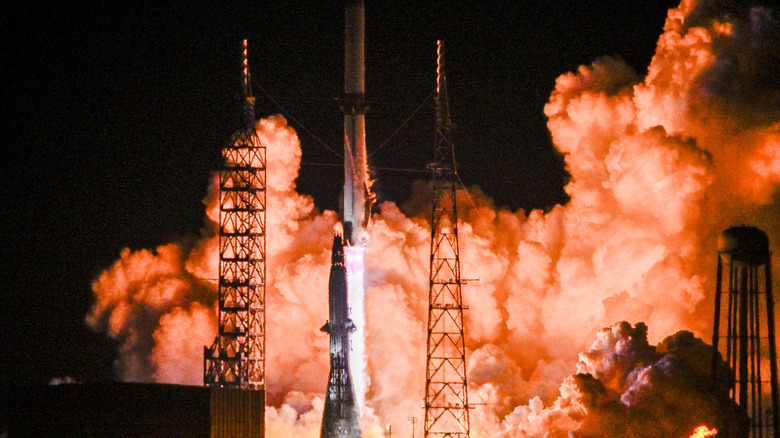SpaceX's Raptor Engine Vs. Blue Origin's BE-4 - What's The Difference In These Rocket Engines
The Earth is much larger than most people realize. You need to use engines if you want to efficiently navigate large sections of the planet. Everything from cars to planes relies on engines, but they use different types of fuel. Some run on gas while others use pure electricity. However, most of these engines are downright worthless when you need to travel to (and then navigate in) outer space.
The biggest hurdle astronauts need to clear before they venture into space is escaping Earth's gravitational pull. Only the most powerful engines spewing gouts of flame can perform this task. And even when that job is finished, rocket ships and space shuttles need a different set of engines that can operate in the cold, oxygen-deprived void of space to reach their destination. Engineers have been refining these spaceship engines to make them more powerful and efficient since the mid-1950s.
Scientists have made some impressive leaps in technology, but the engines that are on everyone's lips today are the SpaceX Raptor and Blue Origin BE-4. These are some of the most powerful rocket engines currently available and were built by companies founded by two of the world's most powerful men – industry icon Elon Musk and Amazon billionaire Jeff Bezos. These private companies are taking humanity to space on the wings of powerful next-generation engines, but is a rocket just a rocket? The differences between the Raptor and BE-4 are both vast and subtle.
An introduction to rocket engines
SpaceX's Raptor and Blue Origin's BE-4 are basically two versions of the same core blueprint: the rocket engine. SpaceX's Raptor engines have been in development since the late 2000s and are planned to power SpaceX's aptly-named Starship, as well as its launch system, dubbed the Super Heavy. Not only are Raptor engines designed for reuse, but Elon Musk intends for these machines to travel as close as the Moon and as far as Mars. With technology evolving, only time will tell if the Raptor can compete with the latest engines coming out of Russia.
Blue Origin's BE-4 fills the same niche as the Raptor. Like the rocket engine, the BE-4 is designed to work with both launch vehicles and boosters, and intended to be low-cost and serve as a reusable rocket. Jeff Bezos claims that each BE-4 will be able to launch up to 100 missions. The first key difference between the Raptor and BE-4 is planned availability. While Musk wants his engines to remain proprietary and serve on SpaceX vehicles, Bezos plans for the BE-4 to be commercially available. Several BE-4s power Blue Origin's New Glenn booster, and United Launch Alliance –- a collaboration between Lockheed Martin and Boeing –- also uses the BE-4 for its Vulcan launch vehicle.
Thrust level is a crucial component
When firing, rocket engines slam passengers into their seats with such overwhelming force that most people would pass out from the pressure. However, not all rockets are built the same way, so the thrust — or the amount of power produced — is slightly different, as in any two car engines of different designs but similar purpose. The Raptor engine is designed to create a thrust of 507,000 pound-force (lbf). Meanwhile, the Blue Origin BE-4 is produces 550,000 lbf.
According to the raw output data (as claimed by the builders), the BE-4 is the more powerful of the two engines, but not by a significant margin. Each spacecraft uses a different number of engines. While a single BE-4 engine outperforms an individual Raptor engine, the SpaceX Super Heavy first-stage booster has more overall thrust because it uses 33 Raptor engines to provide an explosive 16.7 million pounds of thrust. In contrast, the New Glenn's comparatively scant set of seven BE-4 engines produces 3.85 million pounds of thrust for its booster.
Of course, raw numbers aren't everything. In order to be reusable, both engines need to master the ability to land on unusual surfaces. This procedure is known as "deep throttling" and is crucial for smooth landings. The adage "any landing you can walk away from is a good one" doesn't exactly apply when you're hoping to reuse spacecraft.
Propellant and combustion are what makes a rocket move
Fuel is such that many people are switching to electric vehicles (while also scrutinizing their reliability). However, rocket engines require a vastly different fuel source and combustion style than standard engines.
The SpaceX Raptor engine operates on a sub-cooled mixture of liquid methane (CH4) and liquid oxygen, which has a high boiling point and is neither toxic nor corrosive, making it safer and more straightforward to store than conventional fuels. Engineering students even designed and built a graduate-level rocket project fueled by the miracle methalox. The Blue Origin BE-4, in contrast, uses a liquified natural gas (LNG) and liquid oxygen combination.
The Raptor engines utilize a full-flow staged combustion, and the BE-4 an oxygen-rich staged combustion. Both are forms of "staged combustion," where the propellant travels through several chambers and combusts in stages. This method is mechanically complex, converting space fuel into astonishing levels of thrust, along with highly pressurized and searing exhaust. Oxygen-rich combustion cycles burn a small amount of fuel along with a large amount of oxidizer in the preburner. In contrast, a full-flow engine has multiple preburners: one for the oxygen-rich combustion cycle and another for burning a small amount of oxidizer with a lot of fuel. While more complex than oxygen-rich staged combustion engines, full-flow staged engines operate at cooler temperatures and lower pressures, resulting in a longer lifespan.
Chamber pressure is essential for rocket efficiency
As rocket engines are, well, rockets, they move by spewing out ignited fuel. Higher pressures within the combustion chamber yield more efficient performance. The Raptor engine has possibly the highest chamber pressure of any rocket engine. In 2019, the engines achieved a chamber pressure of 257 bar, equivalent to over 3,700 pounds-force per square inch (psi). In 2023, that record was obliterated by the Raptor V3, which achieved 350 bar (over 5,000 psi). Comparatively, the BE-4 lags behind by an ever-widening margin. In 2016, the BE-4 achieved a pressure of 134 bar (1,950 psi).
Virtually all rockets use what is known as a converging-diverging nozzle (CD — alternatively called a de Laval nozzle), through which the exit pressure of the rocket exhaust helps determine the thrust of the rocket. The higher the chamber pressure, the higher the exit pressure, so Raptor engines are more efficient, right? Maybe. In truth, efficiency varies depending on the ambient atmospheric pressure and the difference between it and the exhaust exit pressure, which in turn is determined by the chamber pressure. While perfect efficiency is impossible, it is generally preferable for the exit pressure to be slightly lower than the ambient pressure rather than higher. Fluctuations in pressure both inside and outside the craft are critical to the rocket engine's performance.
Specific impulse tells you how much fuel you're using
We discussed the thrust of the Raptor and BE-4 engines, as well as how chamber pressures contribute to thrust and efficiency. Another element in determining efficiency is "specific impulse," which is affected not only by velocity but also by the propellant's mass and weight. All the fuel in the world can't help you if it doesn't pack enough punch to break gravity's hold on the spacecraft's mass or maneuver effectively in orbit.
The specific impulse is, in essence, the amount of thrust each unit of fuel produces over time. Specific impulse can be measured in velocity provided to the vehicle or in the amount of time a propellant unit can deliver a unit of thrust. The latter is the more common benchmark since it is universal regardless of measurement systems. In 2019, Elon Musk claimed that the Raptor engine's specific impulse was 350 or 380 seconds, depending on the nozzle, whereas Jeff Bezos stated that the BE-4's specific impulse was around 340 seconds.
Here is where the math comes into play. Specific impulse is also the ratio of the thrust the rocket engine produces to the weight flow of the engine's propellants (i.e., how quickly the engine burns through its gas). Higher specific impulse means an engine gets more bang for its buck, or more thrust for less fuel. Since the Raptor has a higher specific impulse regardless of the model, it is the clear winner in this matchup.
Burn time says when a rocket runs out of fuel
The amount of propellant, chamber pressure, and impulse all tie into how efficiently a rocket engine burns its fuel, but one final part of the equation remains: burn time. The longer the burn time, the longer it takes to run out of rocket fuel. While you can aim to achieve a long burn time, such a feat is worthless if the engine isn't efficient and doesn't deliver maximum thrust.
The burn time of a Raptor engine varies depending on the model. For instance, the Raptor 3 achieved a record of 354 seconds (almost six minutes) worth of burn time during one test. The BE-4, meanwhile, only has a recorded burn time of 299 seconds (just shy of five minutes). On the surface, the Raptor engines seemingly burn longer before running out of fuel, but there is one not-so-minor asterisk placed next to every Raptor engine burn record: All of them were tests in controlled environments. SpaceX rockets have consistently experienced engine failures or have not quite met the purported burn time record. Currently, SpaceX vehicles such as the Crew Dragon utilize SuperDraco engines, not Raptor engines.
Bezos' BE-4, meanwhile, has seen promising real-world action. That engine powered the successful January 2024 launch of a Vulcan vehicle to geostationary orbit. The mission was nothing more than a certification, but it took a real rocket up into orbit with real payloads. By comparison, Raptor engine burn times are tantamount to theoretical.






